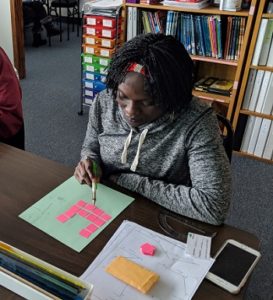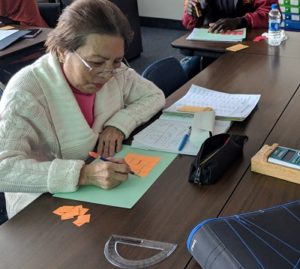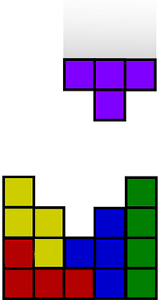- MN ABE Connect
- Archive
- Facilitating 12 Math Groups Got You Feeling Down? Try a Little Coherence! (continued)
 March 18, 2019
March 18, 2019
Facilitating 12 Math Groups Got You Feeling Down? Try a Little Coherence! (continued)
Melody Chalmers, InstructorPlanning instruction in light of the CCRS shift of coherence poses some challenges but offers great rewards. Following from Part 1 and Part 2, this article is Part 3 of a series describing Metro North’s experience with piloting program changes to move toward more coherent math instruction.
Our road to more coherent CCRS math instruction has not exactly followed the geometric definition of a line, (yes, I teach the geometry domain!) but it has led us to much more coherent instruction for our students. Here are four big takeaways that will continue to inform our team’s journey:
Takeaway 1: Coherence Starts with Us
 In K-12 teaching there is the necessity for each of the 13 grade levels to “own” their content and know what comes before and after. For many of us in ABE, however, we may not engage in as much vertical alignment and division of content because, after all, some of us are the 2nd, 3rd, 4th, 5th, and 6th grade math teacher! But, before we could begin planning math instruction for students, we needed to spend time familiarizing ourselves with the standards and observing the connections and progressions within them. One benefit of our math study circle was the dedicated time and targeted support to carry out much of this analysis.
In K-12 teaching there is the necessity for each of the 13 grade levels to “own” their content and know what comes before and after. For many of us in ABE, however, we may not engage in as much vertical alignment and division of content because, after all, some of us are the 2nd, 3rd, 4th, 5th, and 6th grade math teacher! But, before we could begin planning math instruction for students, we needed to spend time familiarizing ourselves with the standards and observing the connections and progressions within them. One benefit of our math study circle was the dedicated time and targeted support to carry out much of this analysis.
Takeaway 2: Coherence Necessitates Collaboration
In order to begin our transition into our flexible math groupings based on standards, we also needed to collaborate as an entire site. Instructors needed to examine the complete patchwork of standards, levels, and domains, and then divide out specific areas for developing groups and expertise. We needed to gather student input and data to inform how the groups would be formed, especially taking into account the delicate balance between assessing language skills and math skills. Those with an eye for detail and logistics established systems and routines, including incorporating new students appropriately into existing groups, and developing formative assessments to determine student growth. And, overseeing these many moving parts, our site supervisor committed staff hours for the study circle, additional planning meetings, and math pedagogy trainings to continue building our capacity.
Takeaway 3: Coherence Acknowledges Student and Staff Experiences, Time, and Talent
Offering instruction with an emphasis on the shift of coherence reflects and respects the reality that our students are already reaching across multiple levels of math standards in order to effectively navigate the complexities of their lives outside of class. I once had a student who was a mother of six children try to tell me she had never worked with fractions. After talking about all the activities she manages for her family, we connected her life’s experiences to CCR math content, and later on she could elicit the mathematics that described the realities of her life. (Are half, less than half, or more than half of my kids ready for school?–That is most definitely working with fractions!)
 Designing instruction with coherence in mind has also led our team to be more purposeful and productive. Instead of feeling scattered by attempting to teach all levels to all students, we have begun to develop deeper understanding of the specific levels, domains, and standards we are tasked with teaching. This focus has benefited students as well. Unlike the literally thousands of hours a typical K-12 student may have to dedicate to math education, the precious few months, weeks, or hours a student may engage with our programming all need to count. Shortly after piloting our new math classes, one student took a teacher aside and held back tears as she expressed excitement and pride at finally grasping a newly-explored skill in her Level A group. She mentioned it was the first time in her life she was learning about the “why” behind math ideas in a systematic way. Another student even changed her work schedule so she wouldn’t have to miss any math class days!
Designing instruction with coherence in mind has also led our team to be more purposeful and productive. Instead of feeling scattered by attempting to teach all levels to all students, we have begun to develop deeper understanding of the specific levels, domains, and standards we are tasked with teaching. This focus has benefited students as well. Unlike the literally thousands of hours a typical K-12 student may have to dedicate to math education, the precious few months, weeks, or hours a student may engage with our programming all need to count. Shortly after piloting our new math classes, one student took a teacher aside and held back tears as she expressed excitement and pride at finally grasping a newly-explored skill in her Level A group. She mentioned it was the first time in her life she was learning about the “why” behind math ideas in a systematic way. Another student even changed her work schedule so she wouldn’t have to miss any math class days!
And in my own math group where we work on Level B geometry standards, I have seen the power of coherence play out. A number of weeks ago we were exploring concepts of area and perimeter with tile pieces, and students began extending their thinking into related (coherent!) ideas within CCRS Level C. At first, I wasn’t sure how to proceed, reasoning that they would revisit this topic in the future when they were working at the Level C. But another “aha” moment came then as I realized they already were engaging with those extended concepts within Level C, and what needed adjustment was the list of standards my course addressed, because students were naturally reaching forward toward related concepts at the next level. So, although I did indeed target and teach standards at Level B in the geometry domain, we also spent time reaching “back” to A standards to fortify some foundational skills, as well as stretching “forward” into level C.
Takeaway 4: Leveling Up – Why Coherence Is Like Tetris
 When we first started out on our circuitous route to flexible math groups, we thought our plan would look “just so” with tall towers of distinct, red Tetris blocks that fit nicely into standards A, B, C, D, and E. As we have moved forward, we’re discovering that it’s much more like playing the game on extreme settings with the speed a little too fast (Yes, you’re getting 5 new students tomorrow!), a few extra-unique zigzag pieces (Your new student has an engineering degree from her home country and just joined your intermediate ESL class!), and what seemed like a good plan didn’t end up being a good fit (What? Our Level D and E groups have only one student?!).
When we first started out on our circuitous route to flexible math groups, we thought our plan would look “just so” with tall towers of distinct, red Tetris blocks that fit nicely into standards A, B, C, D, and E. As we have moved forward, we’re discovering that it’s much more like playing the game on extreme settings with the speed a little too fast (Yes, you’re getting 5 new students tomorrow!), a few extra-unique zigzag pieces (Your new student has an engineering degree from her home country and just joined your intermediate ESL class!), and what seemed like a good plan didn’t end up being a good fit (What? Our Level D and E groups have only one student?!).
Students filter into our program with a math schema with various gaps, but one student’s particular gaps don’t match anyone else’s. We start by laying a strong foundation, even if it has to be built from the ground up. Day by day we work to build new understanding, with some concepts interlocking sideways into other skills, and one new idea balancing precariously on top until a few other supporting concepts come alongside to fill in and stabilize it. As unpredictable, fast-paced, and colorful it has been, our initial results from student TABE data, formative assessments, and student surveys are all indicating that by focusing on coherence, like a well-played game of Tetris, the pieces are finally beginning to fit together.

Newsletter Signup
Get MN ABE Connect—the official source for ABE events, activities, and resources!
Sign UpArticle Categories
- ABE Foundations/Staff Onboarding
- ACES/Transitions
- Adult Career Pathways
- Assessment
- CCR Standards
- Citizenship
- COVID-19
- Cultural Competency
- Digital Literacy/Northstar
- Disabilities
- Distance Learning/Education
- ELA
- Equity/Inclusion
- ESL
- HSE/Adult Diploma
- Listening
- Math/Numeracy
- Mental Health
- Minnesota ABE
- One-Room Schoolhouse/Multilevel
- Professional Development
- Program Management
- Reading
- Remote Instruction
- Science
- Social Studies
- Speaking/Conversation
- Support Services
- Teaching Strategies
- Technology
- Uncategorized
- Volunteers/Tutors
- Writing